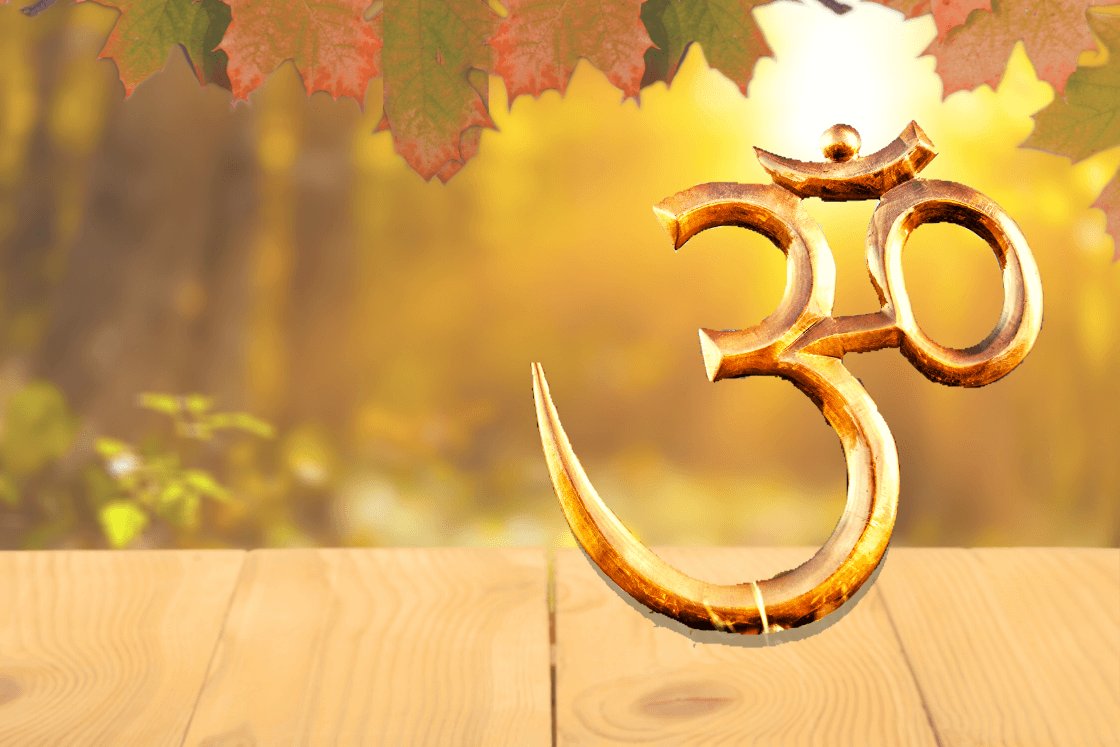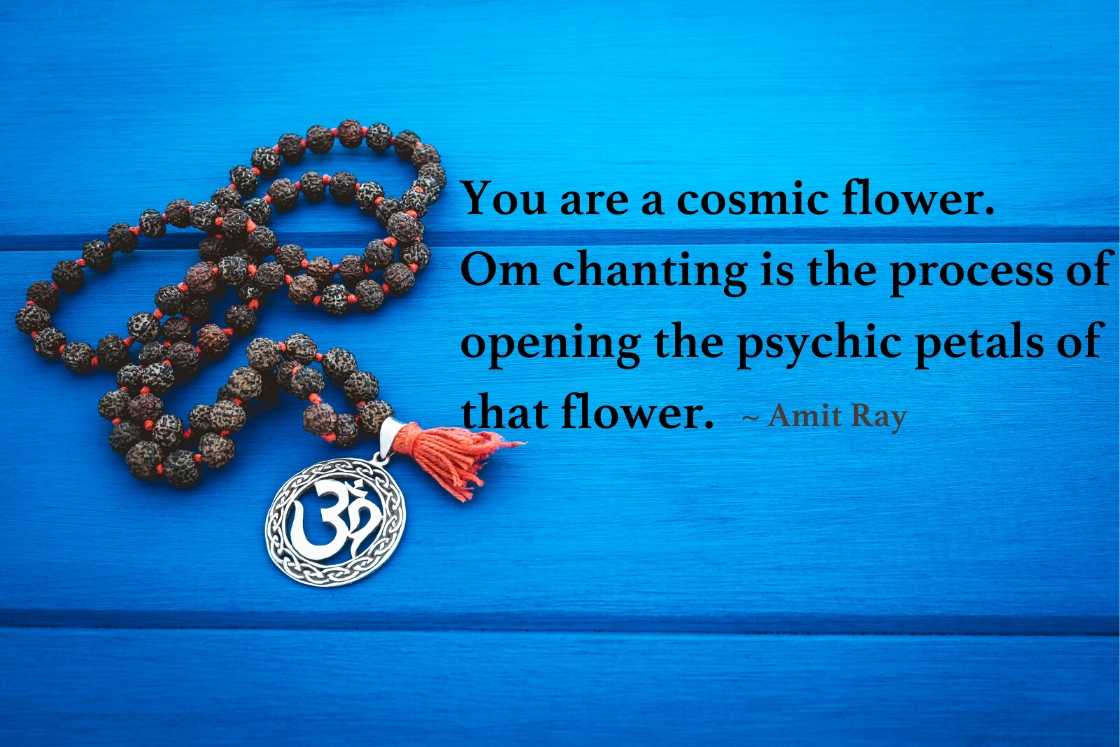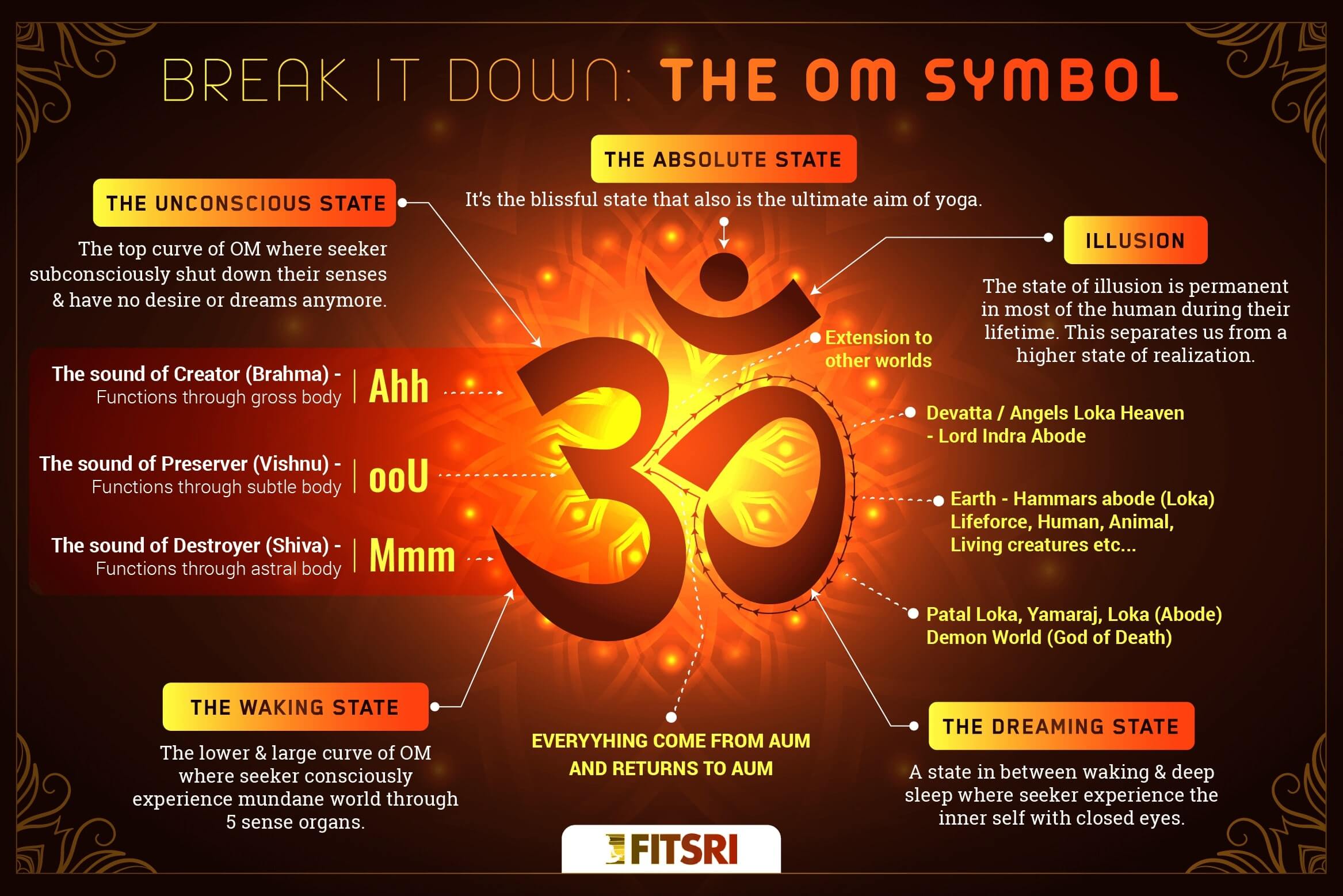
Have you ever noticed how your breath settles after a physical workout or at bedtime after a long, busy day? These quiet moments are often when we truly connect with our inner selves.
When you pay close attention to your breath, you may feel subtle sensations moving through your body. At the centre of this experience, there is a gentle vibration- the sound of OM.
In Hindu philosophy, Brahma, the creator of the universe, was the only presence before anything existed. From Brahma’s wish “to become many,” a vibration emerged. This vibration settled into the primordial sound we know as OM, and from this sound, the universe – the ultimate reality came into existence.
What is OM?
OM, written as the Sanskrit syllable ॐ, carries a vast and powerful resonance. It is the sound believed to pervade the entire universe. In the context of mantras, OM is known as a bija or seed mantra.
As a seed mantra, OM is often used to activate the crown chakra and is placed at the beginning of many saguna mantras mantras that have form, meaning, and a specific manifestation. Because OM gives rise to these saguna mantras, it is also regarded as nirguna an unmanifest sound that exists beyond the three gunas.
Some examples of saguna mantras that arise from OM include:
- Om shanti shanti shanti om
- Om namah shivaya
- Om gan ganapataye namah

In simple terms, OM is the prana you breathe, the essence behind everything you perceive, and the depth of your consciousness itself. It represents the first vibration from which the entire universe emerged.
OM meaning & interpretations
Since OM is nirguna (without attributes), it does not have a fixed, single meaning. However, for understanding and interpretation, OM has been explained in various ways.
The syllable OM comes from the Sanskrit word Omkara (ओंकार). It is also known as Pranava, which means “to bow to the divine with folded hands.” Pranava represents the ultimate reality of the universe.
In hinduism, OM signifies
- Atman – the soul or the self
- Brahman – the supreme truth, the divine
- The union of the three gods or the three gunas
In Jainism, OM represents
- The five supreme beings (Pañca-Parameṣṭhi) — Arihant, Ashiri, Acharya, Upadhyaya, and Muni (A, A, A, U, M → AUM)
In Sikhism, OM refers to
- Ik Onkar – the One God, often seen as the divine creative force
Origin and History
How can we trace the origin of something that is itself considered the origin of everything? This question perfectly reflects the nature of OM.
Although OM is viewed as timeless, its earliest written reference appears in the Upanishads, the ancient Sanskrit texts that form the foundation of spiritual knowledge in Hinduism.
‘The Vayu Purana describes OM as a symbol of the Hindu trinity, showing the unity of three cosmic functions:
- A for Brahma — the creator
- U for Vishnu — the preserver
- M for Shiva — the destroyer
These three sounds also correspond to the three ancient Vedas – Rigveda, Samaveda, and Yajurveda further emphasising OM’s sacred significance.
The Mandukya Upanishad explains OM as the primordial sound that initiated the universe. Before creation, Brahman (absolute reality) existed alone. The divine intention “to become many” produced the first vibration, which unfolded into sound. This sound became known as OM, the seed from which the universe emerged.
Upanishad perspective of OM
In the Mandukya Upanishad, the sages describe OM as a powerful tool for realising the ultimate reality of the self. According to this text, every person experiences three dimensions of perception:
- Waking and the waker’s world – the physical world we perceive through the five senses
- Dreaming and the dreamer’s world – the inner world we experience through impressions and virtual senses during dreams
- Deep sleep and darkness – the state where we encounter silence, stillness, and the experience of “nothingness”
Beyond these three states lies a fourth dimension a pure, undisturbed consciousness that witnesses all experiences yet remains untouched by them. This is the true Self.
The sound of OM symbolically contains these four dimensions.
- The sound “Ahhh” (A) represents the waking state.
- The sound “Ouuu” (U) represents the dreaming state.
- The sound “Mmmm” (M) represents the deep sleep state.
But there is also the silence that follows the “M” sound. This silence is not empty; it symbolises the fourth state the pure Self that transcends waking, dreaming, and deep sleep. Through repeated chanting of OM, one becomes more aware of this inner reality.
For this reason, OM is often described as Atman (the inner soul), Brahman (the ultimate reality), and even the sound of God. In support of this view, Patanjali refers to OM in the Yoga Sutras:
His word is Om.
YSP 1.27
4 Parts of the OM symbol

The symbol of OM holds the knowledge of the universe within its form. Many teachings say that the ultimate goal of human life is hidden in this sacred symbol.
When examined closely, OM has four key components
- Three curved shapes
- One semicircle
- One dot
1. The three curves of OM
- Lower Curve – Waking State (Jagrati): The lower, larger curve represents the waking state. Here, consciousness flows outward through the senses. Its size shows that this is the most common and dominant state for most people.
- Middle Curve – Dreaming State (Swapna): The middle curve represents the dreaming state, which lies between waking and deep sleep. In this state, consciousness moves inward. With eyes closed, the practitioner enters an inner world to explore the self more deeply.
- Upper Curve – Deep Sleep (Sushupti): The upper curve symbolises the deep sleep state, where there are no desires and no dreams. This is a quiet, undisturbed level of consciousness.
2. The dot at the top
The dot represents Turiya, the fourth state of consciousness. In this state, awareness is neither turned inward nor outward. It is a state of pure rest, peace, and bliss the ultimate goal of spiritual practice. Turiya also illuminates and supports the other three states.
3. The semicircle between the curves and the dot
The semicircle symbolises Maya, the barrier that prevents us from realising the highest state of bliss. It separates the individual from Turiya. However, the space between the semicircle and the dot shows that the highest state remains untouched and unaffected by Maya.
In this way, the OM symbol beautifully reveals the hidden purpose of life and the nature of the universe.
Elemental sounds in om
OM is considered the original vibration of the universe. It reflects both Atman (the inner self) and Brahman (the supreme truth). When pronounced, OM divides into three sounds, and each carries a specific meaning.
1. Ah
The sound “Ah” arises at the beginning of the chant. It represents Brahma, the creator. This sound relates to the waking state and connects our gross consciousness to the lower part of the body.
2. Ooh
The middle sound “Ooh” draws the practitioner deeper inward. It represents Vishnu, the preserver. This sound relates to the dreaming state and connects our subtle consciousness to the middle part of the body.
3. Mm
The final sound “Mm” fades gently and leads the practitioner toward the supreme state. It represents Shiva, the destroyer. This sound is linked to the deep sleep state and connects our causal consciousness to the upper part of the body.
Why Do We Chant OM?
Most sounds and speech are produced by moving the tongue. However, when we chant OM, the three sounds Aa, Ooh, and Mm — are created clearly without moving the tongue. This makes OM the most basic and fundamental sound in existence.
Our internal organs are highly sensitive to the vibrations generated by these three sounds. Since OM is considered the sound of creation, chanting it becomes a way of expressing gratitude to the source of all life.
Modern science also suggests that everything in existence is a form of reverberation. Wherever there is vibration, there is sound — and wherever there is sound, creation follows.
Just as a television uses three primary colour webs to create millions of shades, the three sounds of OM combine to produce countless energetic expressions.
- The sound “Aa” is universal. It begins deep in the lower body, near the navel, where the 72,000 nadis (energy channels) meet at the Manipura Chakra. Chanting “Aa” creates a vibration that spreads throughout the entire system.
- The sound “Ooh” expands the vibration upward through the body.
- The sound “Mm” creates a gentle, soothing vibration in the upper regions, especially the head.
Each sound activates a different dimension of the energy system. Together, they stimulate and harmonise the whole body. Sound not only shapes our emotions — it can transform the entire inner state.
This is why chanting OM is considered a science: it helps life unfold within you in its highest intensity and deepest beauty.
Benefits of Chanting OM

OM is a sound whose vibrations are believed to pervade the entire universe. Chanting OM in meditation offers countless benefits on physical, psychological, and emotional levels. With regular practice, this sacred syllable can bring powerful changes to one’s life.
1. OM Cleanses the Surrounding
Chanting OM benefits not only the practitioner but also the environment. The sacred vibrations produced during the chant help dispel negative energies and maintain a positive atmosphere. This is why many traditional spaces use OM chanting to purify and energise the surroundings.
2. Reduces stress and anxiety
According to research, regular OM chanting during meditation helps reduce stress and anxiety.
The vibrations activate specific centres and vagus nerve pathways, which are known to calm the nervous system. OM chanting also influences the endocrine system, helping regulate the chemicals that contribute to stress and anxiety.
3. Strengthens the spinal cord
Chanting OM in a seated posture with a straight spine has a positive effect on the spinal cord.
The sound “Aa” originates near the navel—close to the spinal region—and its vibrations travel upward. These vibrations stimulate the nerves along the spinal cord, supporting better function and overall strength.
4. Improves the digestive system
The digestive system is closely connected to the vagus nerve, which begins in the medulla of the brainstem.
OM chanting stimulates this nerve, helping regulate digestive activity. Many practitioners report better digestion and reduced digestive discomfort with consistent chanting.
5. Maintains the thythmic activity of the heart
Chanting OM has a naturally calming effect on the heart.
The sound “Ooh” rises from the navel towards the upper body and spreads through the chest region. This vibration supports the heart’s natural rhythm and promotes a balanced cardiac cycle.
6. Reduces fatigue by increasing oxygen levels in the blood
A 14-year-old Indian student discovered through her research that chanting OM can help reduce fatigue.
Her study was inspired by seeing priests in Uttarakhand walk long distances while chanting OM continuously. She observed that the rhythmic chanting improved oxygen levels in the blood, which helped reduce tiredness and support physical endurance.
OM Chanting FAQ’S
How many times should I chant the OM mantra?
You won’t be harmed by over uttering or repeating this mantra. However, 108 time OM chanting is considered as the ideal one. But if time is the issue, then one can chant 11 or 21 times for the convenience.
What if I chant the OM mantra in pregnancy?
Garbha sanskar is an ancient Indian ayurvedic practice, which is performed to shape the physical, emotional and spiritual aspects of the unborn child. Chanting OM mantra generates the positive vibrations that calm the mother and the baby as well. Chanting this sacred syllable helps in building the pure environment for the baby in the mother’s womb.
Dawn or dusk, what is the best time to chant the OM mantra?
Normally one can practice the OM mantra at any time, but some fixed timing by the ancient sages is ideal in approach. Brahmamahurta (4 a.m), transition period or when the night is turning into the sunrise (dawn and dusk or sunrise), when the day is turning into night. These some of the timing when you can practice OM mantra chanting.
Can I chant OM mantra while traveling or while sitting in an office?
Yes, you can! There is no problem in chanting the OM mantra while traveling or while sitting in the office. However, OM chanting improves your mood and makes you feel more alive at given places. This helps in a happy journey and a productive day at the office.
What should be the position of my body while chanting OM mantra?
According to the ancient yogis, a sitting position with an erect spine is considered as the ideal position for the mantra chanting. This can be achieved by the Yogic poses, for example, Padmasana (lotus pose).
My kid wants to chant the OM mantra. What should I do?
You should be glad that he/she wants to practice the sacred syllable, which is going to shape his/her in the various aspects of life. There is no age restriction in practicing OM mantra chanting. Any age individual can practice OM chanting.





That semi quantitative nadbindu is Adiparashakti
good information” om’